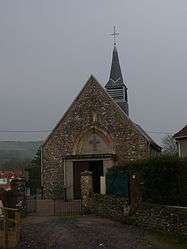Hervelinghen
| Hervelinghen | ||
|---|---|---|
| Commune | ||
 The church of Hervelinghen | ||
| ||
 Hervelinghen Location within Hauts-de-France region  Hervelinghen | ||
| Coordinates: 50°52′57″N 1°42′46″E / 50.8825°N 1.7128°ECoordinates: 50°52′57″N 1°42′46″E / 50.8825°N 1.7128°E | ||
| Country | France | |
| Region | Hauts-de-France | |
| Department | Pas-de-Calais | |
| Arrondissement | Boulogne-sur-Mer | |
| Canton | Desvres | |
| Intercommunality | Communauté de communes de la Terre des Deux Caps | |
| Government | ||
| • Mayor (2008–2014) | Hervé Crépin | |
| Area1 | 5.89 km2 (2.27 sq mi) | |
| Population (2006)2 | 243 | |
| • Density | 41/km2 (110/sq mi) | |
| Time zone | UTC+1 (CET) | |
| • Summer (DST) | UTC+2 (CEST) | |
| INSEE/Postal code | 62444 /62179 | |
| Elevation |
39–157 m (128–515 ft) (avg. 52 m or 171 ft) | |
|
1 French Land Register data, which excludes lakes, ponds, glaciers > 1 km2 (0.386 sq mi or 247 acres) and river estuaries. 2 Population without double counting: residents of multiple communes (e.g., students and military personnel) only counted once. | ||
Hervelinghen is a commune in the Pas-de-Calais department in the Hauts-de-France region of France.
Geography
A small farming village situated near to Wissant, some 13 miles (21 km) north of Boulogne, on the D244 road.
History
It was formerly called Hervemingham, even after the conquest of Calais by the French army. In those days, the population of the village consisted of five English families, who were allowed to remain in their homes when the French commissaires arrived in the village in 1558. To obtain this favour, they argued that they wanted to become loyal subjects of the King of France. Descendants of these families still live in the village.
Since the time of the English occupation, a long stone mast with a cross on the top has stood in the center of the village.
Today, Hervelinghen is a part of the parish of Notre-Dame-des-Flots. Saint-Inglevert Airfield lies to the east of the village.
Population
| Year | 1962 | 1968 | 1975 | 1982 | 1990 | 1999 | 2006 |
|---|---|---|---|---|---|---|---|
| Population | 125 | 149 | 134 | 166 | 172 | 182 | 243 |
| From the year 1962 on: No double counting—residents of multiple communes (e.g. students and military personnel) are counted only once. | |||||||
Places of interest
- The church of St.Quentin, dating from the seventeenth century.
- Two 18th-century farmhouses.
See also
References
External links
| Wikimedia Commons has media related to Hervelinghen. |
- Hervelinghen on the Quid website (in French)
